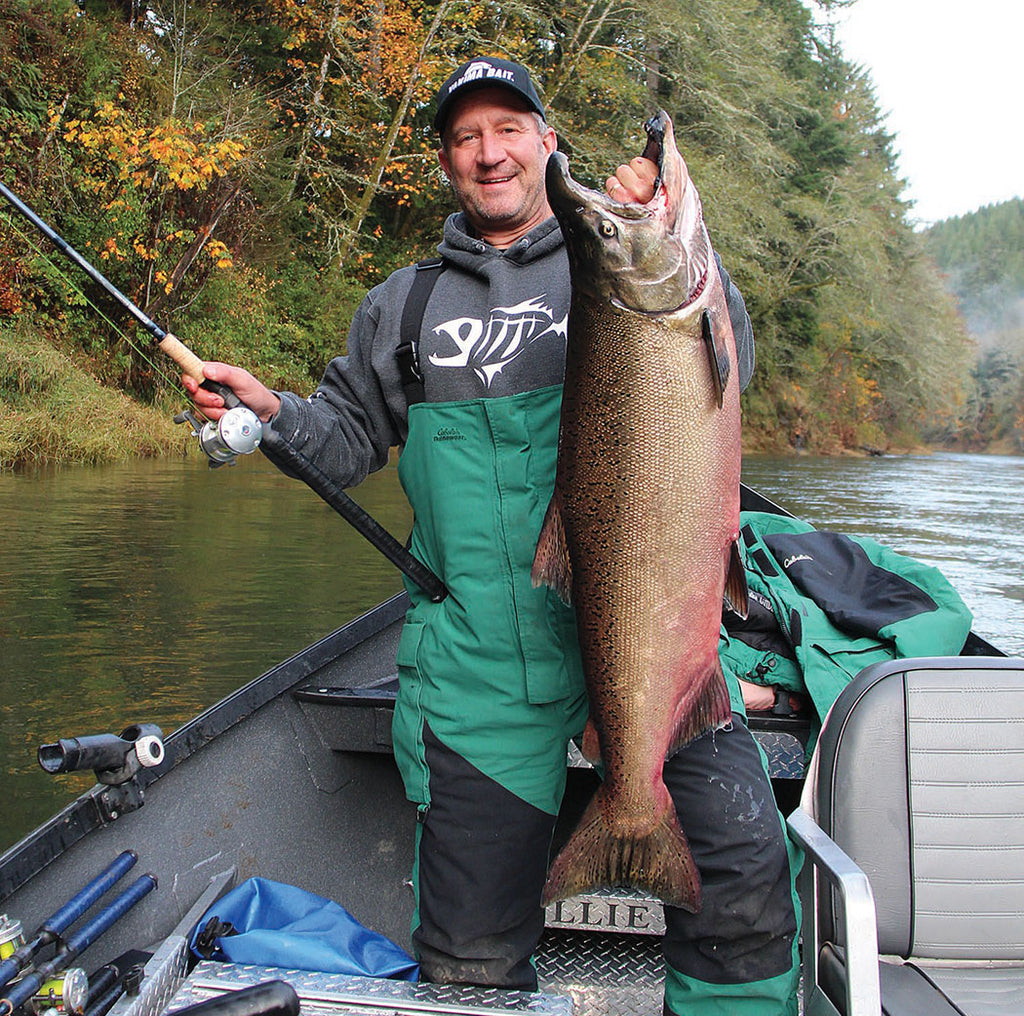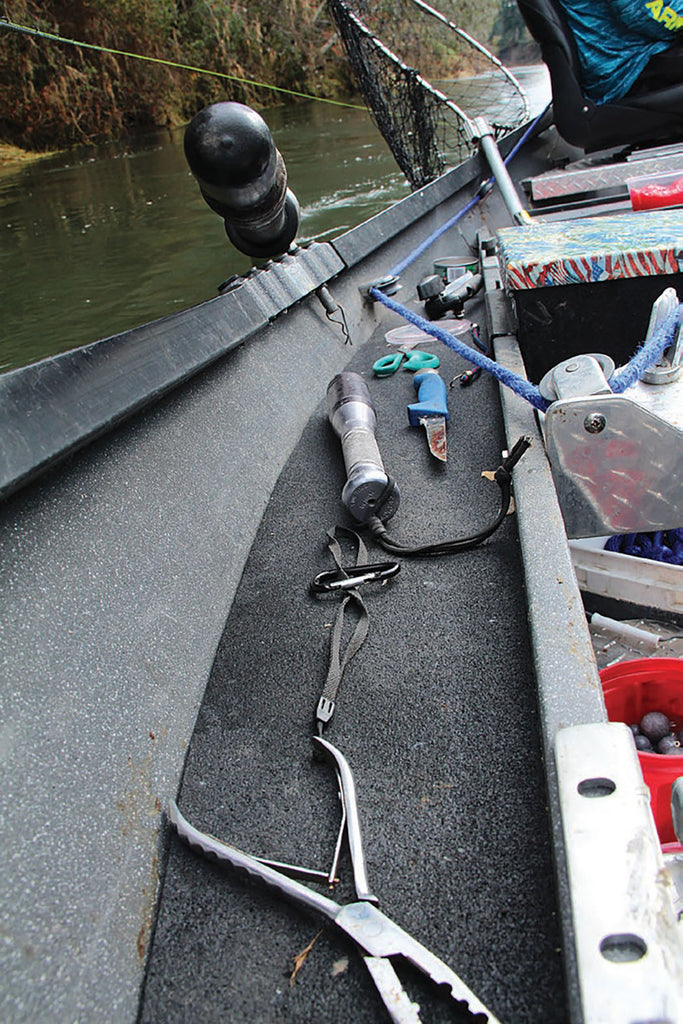In an effort to maximize the operation, handling and the ability to manage all the gear in his boat, Stuart did some things that caught my attention. Whether you’re looking to set up your boat for fall Chinook or winter steelhead, these tips are worth considering.

Scott Haugen with a nice fall Chinook taken last November while fishing with longtime friend and guide, Bret Stuart of 24/7 Guide Service. As with all his trips with Stuart, the author learned a lot.
There he is!” Exclaimed Bret Stuart, throttling the kicker as I struggled to pull the rod from the holder. Fifteen minutes later, and 200 yards downstream from where we hooked the fish, it was finally in the boat. The big, fat, fall Chinook hit a back-trolled plug, hard. Once hooked, the fish went where it wanted to. When we saw the size of the beast, we agreed not to horse it in, so I kept fighting it as Stuart handled the boat.
The fish, a copper-hued buck, would tip the scales to more than 30 pounds. It was a great way to start the day, seeing as how we caught it in the first hole, in the first two minutes of morning fishing.
By day’s end on the small coastal stream of Oregon we’d have our limits of Chinook, and release a couple wild coho. The next two Chinook came on diver and bait, and the final fish, by way of backbouncing.
I like fishing multiple ways, and that’s one thing I love about fishing with longtime friend and guide, Bret Stuart, owner of 24/7 Guide Service (541-521-4694). Stuart isn’t afraid to try new things. I’ve seen him try approaches and setups I’ve never heard of; some failed, and we laughed, while others worked and left us speechless.
A few years had passed since I’d been in Stuart’s drift boat, and that, in itself, was a treat. Rarely have Stuart and I been skunked in our nearly 20 years of fishing salmon and steelhead together, so limiting out on this day wasn’t a surprise. What stuck out in my mind, however, was how he’d decked out his drift boat.
In an effort to maximize the operation, handling and the ability to manage all the gear in his boat, Stuart did some things that caught my attention. Whether you’re looking to set up your boat for fall Chinook or winter steelhead, these tips are worth considering.
Rubber Matting

Stall mat, custom cut to fit your boat, keeps things quite, clean and holds items in place.
Guided by the beam of my headlamp, when I set foot in Stuart’s boat, I instantly noticed how clean and quiet it was. Haul-ing gear into a boat, I set it on the bow, in the side trays, and on the floor. I put tackle, camera gear and a dry bag in all of those places, and they hit with silence.
As daylight came, I saw that Stuart had lined the bow, both side trays and parts of the floor with 1/4-inch stall mat. It was dense matting, like what you’d find in a horse barn, and it was quiet and clean. “I don’t care about the little extra weight it might add, because it helps keep things clean and quiet, and no matter what gear you put on it, it stays in place,” Stuart shares. “Set your pliers there, and that’s where they’ll be when you need them, no matter how many rapids you go through.”
On the November day we fished together last year, the weather was good, with no rain. I had all my camera gear set out on the deck, and it stayed put and was silent. Loud, sharp noises can scare fish in small streams, and with this matting, there’s no worry of that. Should the matting get fish slime, eggs or other fishy smells on it, just hose it off. Stuart got the mat at Coastal Farm, and it can be found many places, online.
Rod Noodle Protectors

A simple, economical way to protect your rods when traveling.
When Stuart and I fish together, there are lots of rods in the boat. This trip, we had over a dozen on board, and in order to keep them from bouncing around and hitting one another, possibly fracturing and break-ing, Stuart wrapped them in foam.
Specifically, he took a foam pool noodle, cut it into 12-inch long sections, slit it open down the side, then wrapped it around two rods. “It’s perfect for one-piece rods, as you just put the noodle where the rods might come into contact with the gunnels of the boat, or anything in the back of your truck,” Stuart points out. “Just move the noodles to wherever the points of contact are, and you’re set.”
We traveled with some rods in the boat and some in the back of the truck, and the noodles did their job very well. Once on the river, we took the rods out as we needed them, and put them back in the noodles at the end of the day. It was simple, quiet and protected the rods.
Bow Heater
When Stuart had his drift boat built, he made sure there was a drawer put in the bow. “You wouldn’t believe how many clients comment on this thing at the end of the day, especially on those cold winter steelhead days,” Stuart smiles.
While the drawer is a great place to stow gear, what Stuart says his clients really like is the fact it’s positioned right above the heater, which is below the bow. “They’ll bring their lunch, say burritos, chicken, pizza, or whatever else, and put it in foil, inside the drawer. In a short time they have a hot meal, ready to go. They love it, and so do I.”
The heater under the bow is also in a great location, as it keeps you warm all day long. It’s strategically located for keep-ing the feet and legs toasty, as well as the hands and face.
Bilge Pump

If you spend much time in your drift boat, a bilge pump is a luxury worth considering.
Something you don’t see often in a drift boat is an electric bilge pump, but Stuart has one. The electrical unit connects to a battery in the back of the boat, where the switchboard is, and the motor is situated in the middle of the boat, at the lowest point on the floor.
Split tubing sleeves protect the wiring running alongside of the boat, under the side trays, and a custom diamond plate housing protects the intake unit. The drain hose runs straight up the side of the boat and out the side. No more bailing water!
Kicker Seat

A kicker motor with a swivel seat installed on a level platform makes those long days on the river, very comfortable. Here, guide Bret Stuart works a backtrolled plug close to shore.
As with many drift boats these days, Stuart has a kicker motor on the back of his. “I have such good control when backtrolling with the kicker, and it’s so quiet, that’s what I use rather than pumping on the oars all day,” smiles Stuart.
To maximize his comfort, Stuart had a level platform installed in the back of his boat, one with a sliding swivel seat. The setup is ideal, as not only does it allow for easy, comfortable operation of the boat, but you can see all that’s going on around you, and your back isn’t fatigued by the end of the day.

Fish Box Fillet Board
When it came time to clean our catch, Stu-art handed me the fish box. I went to lift a couple fish from it, and he said to grab the whole box. We went to river’s edge with it, where we took the fish out and turned the fish box upside down. On the underside were two long strips of anti-slip traction tape, similar to coarse sandpaper. It was ingenious; a cutting board that actually held the fish in place and took up no extra room in the boat.
Rather than carry a cutting board, or butchering the fish on a dirty riverbank, the underside of the fish box was the perfect cleaning platform. I was impressed with how well the coarse grained paper kept the fish carcass secure, making the butchering easy and clean. When done, simply give it a quick splash and a wipe down and it’s ready for the next trip.
Leader Rigs

Simply adding a little flash, like this wedding ring, to your terminal gear setup, can make a difference in getting fish to bite.
On the fishing side of things, pre-tied leaders are something most experienced anglers hit the water with. After all, this saves time when re-tying riggings, meaning your actual fishing time increases. But on Stuart’s pre-tied leaders, I noticed some bling, and I liked it.
“I love running a Spin-N-Glo when backtrolling and backbouncing for Chinook, and in an effort to increase visibility, I added a wedding ring to each rig,” points out Stuart. “Put those things in the water and look how much flash they add.”
The wedding rings, or diamond bands, are slid onto the leader, between two beads, with the Spin-N-Glo sitting on top of the bead. We caught three Chinook and two coho on this setup the day we fished.
Bait Switch
While on the subject of terminal gear, don’t be afraid to change out bait offerings. “If I’m the first one into a fall Chinook hole, I’m likely going to run a plug through it, or diver and bait,” begins Stuart. “But if there’s a boat or two ahead of me, I sit back, watch what they are using, then try to go in with something different.”
Case in point. One hole Stuart wanted to fish had a boat in it. So, we dropped anchor, broke out some snacks, sat and watched. As soon as the boat hit the end of the drift, without a strike, Stuart put the binoculars to work. “Great, they’re running plugs, so get the diver rods out and bait ‘em up.”
As Stuart maneuvered the boat, I added fresh eggs to both of our rods. We made a pass through the same section of water as the boat in front of us, without even a strike. “This water is perfect, there has to be fish in here,” Stuart pondered. “Rebait, we’re running it again.”
This time I added sand shrimp to the fresh eggs, Stuart instantly latched into a chrome Chinook. We made one more pass and plucked another fish from the same spot. It was mid-day, so I suspect those fish were there the whole time, we just had to find something they liked, and they liked the smell of sand shrimp.
Wrapping your plugs with various baits can be all the change it takes to turn on the bite. But having the flexibility to backtroll a diver and bait, or backbounce bait, even pull over and drift fish a section of water, opens up a lot of opportunities.
This season, whether you’re targeting fall Chinook or winter steelhead, consider setting up your boat so it’s as functional and efficient as possible. For more than 45 years I’ve been fishing from a drift boat, and what I continue learning from fellow anglers like Stuart, amazes me. Think stealth, cleanliness, ease of handling and diversification, and get ready for a season of fun, productive fishing.

MORE GREAT ARTICLES FROM STS










